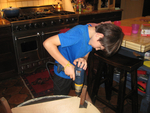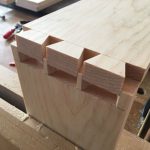We may receive a commission when you use our affiliate links. However, this does not impact our recommendations.
Editor’s note: This is an excerpt from The Handy Shop Reference by Tom Begnal. This book contains tons of info, including everything from basic math for woodworkers to choosing hardware and finishes to standard furniture dimensions and joints.
How to Draw an Ellipse
Various methods are used to create an ellipse. The method shown here, often called the trammel method, is relatively simple and you can use it to make an ellipse of just about any size.

1. Draw a horizontal line slightly longer than the length of the ellipse, then draw a vertical line slightly longer than the ellipse width. Make sure the lines are perpendicular to each other.

2. Mark Points X, Y and Z on a straightedge made from cardboard, stiff paper or a thin piece of wood. XZ should be equal to one-half the length of the ellipse and XY should be equal to one-half the width of the ellipse.

3. Position the straightedge so that Point Z falls along the vertical line and Point Y falls along the horizontal line. Hold the straightedge in position, then mark Point X, which represents a point on the circumference of the ellipse.

4. Continue moving the straightedge, always keeping Point Z on the vertical line and Point Y on the horizontal line. Mark a new Point X after each movement of the straightedge. Mark as many points as needed to create a smooth curve along the entire circumference of the ellipse.
Woodshop Application
Draw an elliptical tabletop that measures 48″ long by 30″ wide.

1. Draw a horizontal line at least 48″ long on the glued-up stock for the tabletop. At the midpoint of the horizontal line, draw a vertical line at least 30″ long. Make sure the lines are perpendicular to each other.

2. Mark Points X, Y and Z, using a straightedge, so that XZ equals 24″ and XY equals 15″.

3. Position the straightedge so that Point Z falls along the vertical line and Point Y falls along the horizontal line. Hold the straightedge in position, then mark Point X, which represents a point on the circumference of the ellipse.

4. Continue moving the straightedge, always keeping Point Z on the vertical line and Point Y on the horizontal line. Mark a new Point X after each movement of the straightedge. Mark as many points as needed to create a smooth curve along the entire circumference of the ellipse.
Find fast answers to woodworking questions! From fasteners to finishing, angles to adhesives, this portable guide is packed with helpful charts, lists and illustrations to move readers’ woodworking projects along. Need to compute an odd joint angle, select appropriate hardware, or pick the right finish for a project? Readers can consult the Handy Shop Reference for solutions to those dilemmas and many more.
Here are some supplies and tools we find essential in our everyday work around the shop. We may receive a commission from sales referred by our links; however, we have carefully selected these products for their usefulness and quality.










